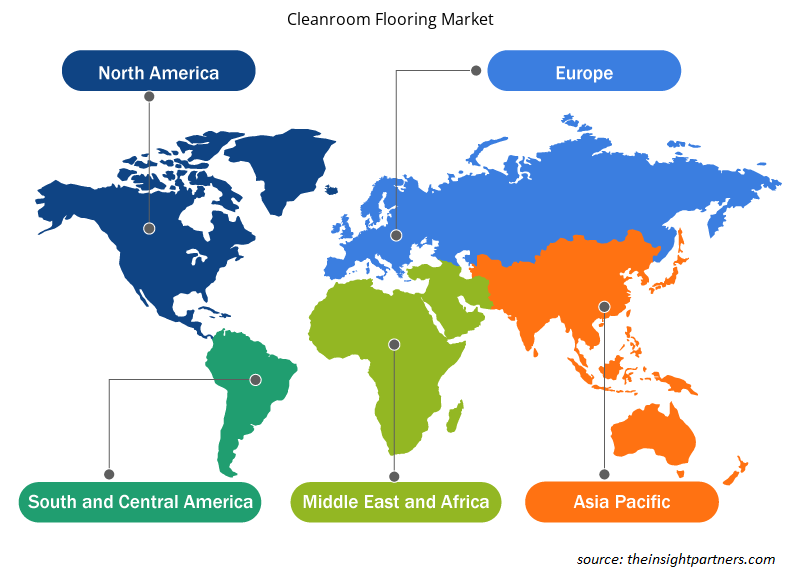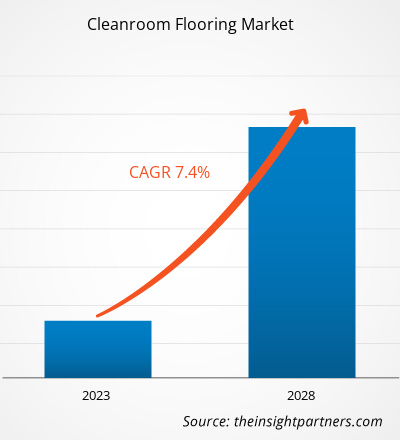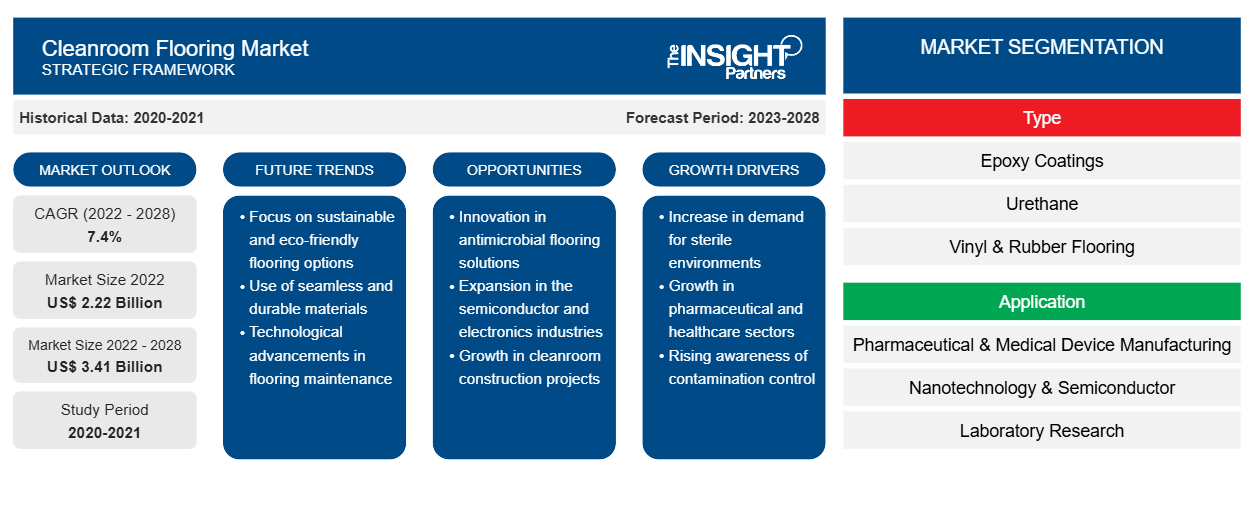Se espera que el mercado de pisos para salas blancas alcance los US$ 3.405,39 millones para 2028; se estima que crecerá a una CAGR del 7,4% entre 2022 y 2028.cleanroom flooring market is expected to reach US$ 3,405.39 million by 2028; it is estimated to grow at a CAGR of 7.4% from 2022 to 2028.
Una sala limpia se refiere a un ambiente controlado con niveles bajos de contaminantes, como partículas, microorganismos, polvo y aerosoles. Los pisos para salas limpias se utilizan en las industrias farmacéutica y de electrónica y semiconductores para evitar los efectos potencialmente dañinos de la contaminación del aire y las partículas diminutas durante el proceso de fabricación del producto. La industria de la tecnología de salas limpias ofrece diversos medicamentos, artículos farmacéuticos y equipos. La demanda de desinfección de hospitales está aumentando rápidamente. La tecnología de salas limpias ha atraído cada vez más atención. La propagación de virus y bacterias dañinos es la razón principal para promover la demanda de pisos para salas limpias.
Además, las regulaciones sanitarias más estrictas, los estándares rígidos, la demanda de productos de alta calidad por parte de los consumidores, el aumento de la frecuencia y la conciencia pública sobre las enfermedades infecciosas y contagiosas, el aumento de la necesidad de medicamentos y vacunas y la expansión de la infraestructura sanitaria están impulsando el crecimiento del mercado de suelos para salas blancas . Además, el creciente consumo de dispositivos electrónicos de consumo en todo el mundo está impulsando la demanda de semiconductores. Asimismo, la aparición de la Internet de las cosas (IoT), la inteligencia artificial (IA) y el aprendizaje automático (ML) está ofreciendo oportunidades de crecimiento al mercado de semiconductores, ayudando a los chips de memoria a procesar grandes cantidades de datos en menos tiempo. Las instalaciones de nanotecnología y semiconductores deben estar libres de polvo y partículas debido a la sensibilidad de las operaciones tecnológicas. Los acabados de los suelos en estas instalaciones incluyen la presencia de una base de zócalo de suelo a pared sin líneas de lechada ni bordes de baldosas, lo que crea un entorno libre de polvo. Estos factores están impulsando el mercado de este segmento. Además, la creciente demanda de chips de memoria avanzados y más rápidos en aplicaciones industriales está impulsando el crecimiento del mercado de semiconductores.
Personalice este informe según sus necesidades
Obtendrá personalización en cualquier informe, sin cargo, incluidas partes de este informe o análisis a nivel de país, paquete de datos de Excel, así como también grandes ofertas y descuentos para empresas emergentes y universidades.
-
Obtenga las principales tendencias clave del mercado de este informe.Esta muestra GRATUITA incluirá análisis de datos, desde tendencias del mercado hasta estimaciones y pronósticos.
Perspectivas del mercado
La creciente demanda de las industrias farmacéutica y de fabricación de productos electrónicos impulsa el crecimiento del mercado de suelos para salas blancas
Los sectores más habituales que utilizan salas blancas son los de fabricación de productos farmacéuticos, dispositivos médicos y ciencias biológicas. Estos sectores están experimentando una demanda sin precedentes de kits de pruebas diagnósticas y consumibles, equipos de protección personal, respiradores médicos y otros suministros médicos esenciales. La mayoría de estos productos deben fabricarse en instalaciones libres de contaminación, lo que indica la importancia de las salas blancas en estos sectores. Además, el aumento del número de hospitales y centros de cirugía ambulatoria está impulsando la demanda de salas blancas, ya que necesitan mantener al mínimo la carga de partículas en suspensión en sus instalaciones. Varias marcas líderes de electrónica de consumo, incluidas Apple y Samsung, están realizando enormes inversiones en el lanzamiento de nuevos dispositivos para satisfacer la creciente demanda de dispositivos avanzados. La industria de semiconductores, en rápido crecimiento, está impulsando la demanda de salas blancas, lo que, a su vez, está ayudando al crecimiento del mercado de suelos para salas blancas.
Tipo de información
Según el tipo, el mercado de pisos para salas blancas se segmenta en revestimientos de epoxi, uretano, pisos de vinilo y caucho, pisos de metacrilato de metilo y otros. En 2021, el segmento de revestimientos de epoxi dominó el mercado. Un revestimiento de epoxi está diseñado para brindar una mejora estética y protección a una superficie. La ventaja del revestimiento de epoxi es su revestimiento denso, que tiene una baja porosidad, lo que lo hace fuerte y duradero bajo un tráfico intenso y fácil de limpiar y mantener. Se puede aplicar en varias opciones de color y rendimiento que pueden soportar productos químicos corrosivos y disipar la estática. Estos beneficios del revestimiento de epoxi están impulsando el mercado de este segmento.
Gerflor SAS, Easypharma SRL, Lindner AG, Forbo Flooring India Pvt Ltd. y Polyflor Ltd. se encuentran entre los actores clave que operan en el mercado de pisos para salas blancas. Los principales actores adoptan estrategias como fusiones y adquisiciones y lanzamientos de productos para expandir su presencia geográfica y su base de consumidores.
Perspectivas regionales del mercado de suelos para salas blancas
Los analistas de Insight Partners explicaron en detalle las tendencias y los factores regionales que influyen en el mercado de pisos para salas blancas durante el período de pronóstico. Esta sección también analiza los segmentos y la geografía del mercado de pisos para salas blancas en América del Norte, Europa, Asia Pacífico, Medio Oriente y África, y América del Sur y Central.

- Obtenga datos regionales específicos para el mercado de pisos para salas blancas
Alcance del informe de mercado de suelos para salas blancas
| Atributo del informe | Detalles |
|---|---|
| Tamaño del mercado en 2022 | US$ 2.22 mil millones |
| Tamaño del mercado en 2028 | US$ 3,41 mil millones |
| CAGR global (2022-2028) | 7,4% |
| Datos históricos | 2020-2021 |
| Período de pronóstico | 2023-2028 |
| Segmentos cubiertos |
Por tipo
|
| Regiones y países cubiertos |
América del norte
|
| Líderes del mercado y perfiles de empresas clave |
|
Densidad de actores del mercado de suelos para salas blancas: comprensión de su impacto en la dinámica empresarial
El mercado de suelos para salas blancas está creciendo rápidamente, impulsado por la creciente demanda de los usuarios finales debido a factores como la evolución de las preferencias de los consumidores, los avances tecnológicos y una mayor conciencia de los beneficios del producto. A medida que aumenta la demanda, las empresas amplían sus ofertas, innovan para satisfacer las necesidades de los consumidores y aprovechan las tendencias emergentes, lo que impulsa aún más el crecimiento del mercado.
La densidad de actores del mercado se refiere a la distribución de las empresas o firmas que operan dentro de un mercado o industria en particular. Indica cuántos competidores (actores del mercado) están presentes en un espacio de mercado determinado en relación con su tamaño o valor total de mercado.
Las principales empresas que operan en el mercado de suelos para salas blancas son:
- Tecnología limpia AES Inc.
- Gerflor SAS
- Easypharma SRL
- Industrias de salas blancas Sdn Bhd
- EP Pisos Corp
Descargo de responsabilidad : Las empresas enumeradas anteriormente no están clasificadas en ningún orden particular.

- Obtenga una descripción general de los principales actores clave del mercado de pisos para salas blancas
Informe Destacado
- Tendencias progresivas en la industria de pisos para salas blancas que ayudarán a los actores a desarrollar estrategias efectivas a largo plazo
- Estrategias de crecimiento empresarial adoptadas por las empresas para asegurar el crecimiento en los mercados desarrollados y en desarrollo
- Análisis cuantitativo del mercado mundial de suelos para salas blancas de 2020 a 2028
- Estimación de la demanda de suelos para salas blancas en diversas industrias
- Análisis de las cinco fuerzas de Porter para ilustrar la eficacia de los compradores y proveedores que operan en la industria de pisos para salas blancas
- Desarrollos recientes para comprender el escenario competitivo del mercado y la demanda de pisos para salas blancas
- Tendencias y perspectivas del mercado junto con los factores que rigen el crecimiento del mercado de pisos para salas blancas
- Comprender las estrategias que sustentan el interés comercial con respecto al crecimiento del mercado, ayudando en el proceso de toma de decisiones.
- Tamaño del mercado de suelos para salas blancas en varios nodos del mercado
- Descripción detallada y segmentación del mercado, así como su dinámica industrial.
- Tamaño del mercado de suelos para salas blancas en varias regiones con prometedoras oportunidades de crecimiento
El "Análisis del mercado de suelos para salas blancas hasta 2028" es un estudio especializado y profundo de la industria de productos químicos y materiales, centrado en el análisis de tendencias del mercado. El informe tiene como objetivo proporcionar una descripción general del mercado con una segmentación detallada. El mercado de suelos para salas blancas está segmentado en función del tipo, la aplicación y la geografía. Según el tipo, el mercado se segmenta en revestimientos de epoxi, uretano, suelos de vinilo y caucho, suelos de metacrilato de metilo y otros. En términos de aplicación, el mercado de suelos para salas blancas está segmentado en fabricación de productos farmacéuticos y dispositivos médicos, nanotecnología y semiconductores, investigación de laboratorio y otros. Según la geografía, el mercado está segmentado en cinco regiones principales: América del Norte, Europa, Asia Pacífico, Oriente Medio y África, y América del Sur y Central. En 2021, América del Norte dominó el mercado de suelos para salas blancas, y se espera que la región de Asia Pacífico registre la CAGR más alta del mercado durante el período de pronóstico. Se prevé que factores como el aumento de las inversiones en investigación y desarrollo y el aumento de nuevos estudios de investigación, como la terapia celular y la investigación con células madre, respalden el crecimiento del mercado de pisos para salas blancas en los países de Asia Pacífico.
- Análisis histórico (2 años), año base, pronóstico (7 años) con CAGR
- Análisis PEST y FODA
- Tamaño del mercado, valor/volumen: global, regional y nacional
- Industria y panorama competitivo
- Conjunto de datos de Excel
Informes recientes
Testimonios
Razón para comprar
- Toma de decisiones informada
- Comprensión de la dinámica del mercado
- Análisis competitivo
- Información sobre clientes
- Pronósticos del mercado
- Mitigación de riesgos
- Planificación estratégica
- Justificación de la inversión
- Identificación de mercados emergentes
- Mejora de las estrategias de marketing
- Impulso de la eficiencia operativa
- Alineación con las tendencias regulatorias























 Obtenga una muestra gratuita para - Mercado de suelos para salas blancas
Obtenga una muestra gratuita para - Mercado de suelos para salas blancas